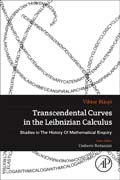
Transcendental Curves in the Leibnizian Calculus analyzes the mathematical and philosophical conflict between Euclidean and Cartesian mathematics. For millennia, mathematical meaning and ontology had been anchored in geometrical constructions, as epitomized by Euclid's ruler and compass. As late as 1637, Descartes had placed himself squarely in this tradition when he justified his new technique of identifying curves with equations by means of certain curve-tracing instruments, thereby bringing together the ancient constructive tradition and modern algebraic methods in a satisfying marriage. But rapid advances in the new fields of infinitesimal calculus and mathematical mechanics soon ruined his grand synthesis. Descartes's scheme left out transcendental curves, i.e. curves with no polynomial equation, but in the course of these subsequent developments such curves emerged as indispensable. It was becoming harder and harder to juggle cutting-edge mathematics and ancient conceptions of its foundations at the same time, yet leading mathematicians, such as Leibniz felt compelled to do precisely this. The new mathematics fit more naturally an analytical conception of curves than a construction-based one, yet no one wanted to betray the latter, as this was seen as virtually tantamount to stop doing mathematics altogether. The credibility and authority of mathematics depended on it. Brings to light this underlying and often implicit complex of concerns that permeate early calculusEvaluates the technical conception and mathematical construction of the geometrical methodReveals a previously unrecognized Liebnizian programmatic cohesion in early calculusProvides a beautifully written work of outstanding original scholarship INDICE: 1. Preliminary matters 2. Introduction 3. The classical basis of 17th-century philosophy of mathematics 4. Mathematical context 5. Transcendental curves by curve tracing 6. Transcendental curves analytically: exponentials and power series 7. Transcendental curves by the reduction of quadratures 8. Transcendental curves in physics 9. A view from the 18th century 10. Concluding overview
- ISBN: 978-0-12-813237-1
- Editorial: Academic Press
- Encuadernacion: Rústica
- Páginas: 282
- Fecha Publicación: 01/06/2017
- Nº Volúmenes: 1
- Idioma: Inglés
